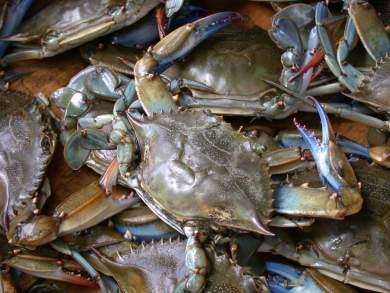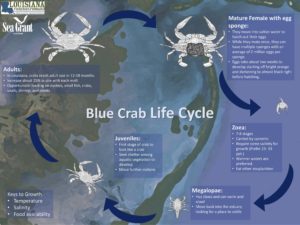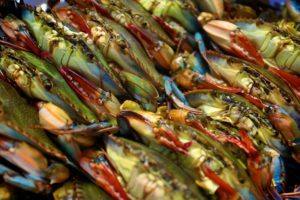Crab
Louisiana supports the largest crab production of hard blue crabs in the nation and is the number one supplier of live No. 1 male crabs in the southern states. The blue crab is one of the most popular of the more than 4,500 species of crabs found worldwide.
Blue crabs are found from northern Massachusetts to northern Argentina and throughout the Gulf of Mexico. They inhabit estuarine and coastal waters throughout Louisiana, however more than half of the crabs in Louisiana are harvested from Lake Pontchartrain and the Terebonne basins. Our fishermen harvest blue crabs year-round with peak catches in the summer months of June, July, and August.
Crabs have a hard-outer shell, or exoskeleton. The shell cannot stretch as the crabs grow and therefore they must molt, or shed their shells in order to grow. During their lifespan, lasting typically around 3 years, the shedding process happens over and over again, as often as 25 times.
Crabs are decapods which means they have 10 appendages; 4 pairs of walking legs and one pair of pincher-like claws used to trap and catch prey items as well as defense against predators. Their backside set of legs are shaped like paddles to allow for more efficient swimming. Their four frontal teeth distinguish them from other similar species.
There are two ways to tell the difference between male and female blue crabs, claw color and ventral “apron” shape. Adult male crabs will have bright blue claws, while the female crabs have red tips. The abdomen or underside of a crab has what’s commonly known as an apron. In males, that apron is long and pointy, whereas in the females the apron is wider and rounder in shape. Immature females have triangle shaped bottoms and are called “v-bottoms”.

The Atlantic Blue crab (Callinectessapidus)species is the main species of crab caught and harvested in Louisiana, however, the Ornate Blue crab (Callinectes ornatus), Lesser Blue crab (Callinectes similis), and Gulf stone crabs are also found and caught in Louisiana waters but do not contribute significantly to commercial landings.
 Crab availability varies with the season and is affected by the crab’s life cycles, abundance, and size. Since the crabs undergo a number of molts as they grow, you can catch a composition of stages during different times of the year, hard-shell, peelers (about to shed), and soft-shell (just shed).
Crab availability varies with the season and is affected by the crab’s life cycles, abundance, and size. Since the crabs undergo a number of molts as they grow, you can catch a composition of stages during different times of the year, hard-shell, peelers (about to shed), and soft-shell (just shed).
Live, hard shell crabs are available all year long, but are most plentiful and meaty during the warmer months when feeding activity increases with warmer waters and are less available during colder months with March being the scarcest. Crabs are also found in freshwater but are simply saltwater crabs that have migrated inland to rivers and lakes.
Soft-shell crabs are available primarily from March through November with the most productive months from May to September. Crabs at this stage are hard to find when the temperature drops below 50degreesF.
Hard Shell Crabs
A legal-sized hard crab in Louisiana must measure 5 inches shell width (point to point). Larger crabs can usually command higher prices. There are no standard industry grades for hard and soft-shell crabs. Consumers will find crab sizes referred to as large, medium, and small, or more commonly graded as number one (male “jimmies”, most meaty), number twos (male “jimmies”, less meaty), and number threes (mix of ungraded, small crabs, often females). Most hard shell crabs are sold by the dozen, bushel or crate. A dozen crabs are exactly 12 crabs. The actual number of crabs in a bushel depends on the size of the crabs. To avoid confusion when ordering hard shell crabs, buyers should specify the size desired (in inches) and use the following table as a guide:
| SIZE NAME | CRAB DIMENSIONS | DOZENS PER BUSHEL | CRABS PER BUSHEL |
| Number One | 6 ½ or more inches | 4-5 dozen | 48-60 crabs |
| Number One/Two | 6 – 6 ½ inches | 5 – 6 dozen | 60 – 72 crabs |
| Number Two | 5 ½ – 6 inches | 6 – 7 dozen | 72 – 84 crabs |
| Number Three | 5 – 5 ½ inches | 7 – 8 dozen | 84 – 96 crabs |
Fat Crabs vs. Empty Crabs: Those crabs that are empty or light in weight have recently molted. A larger new crab shell is produced through the molting process to allow for growth. That same lighter, empty crab will fill with muscle over time and become a full fat crab. This cycle will continue until maturity. Crabs that have just molted are bright, clean and shiny. Full crabs tend to appear darker and more discolored.
Soft-shell Crabs
For soft-shell crabs, dozens are generally sold “straight-run,” which includes all sizes, or graded as small, medium, and large. Individual producers may sell by weight or other means. Thus, to avoid confusion when buying soft-shell crabs, buyers should specify by size (in inches) or weight. See sizing and weight chart provided as a guide:
| CRAB DIMENSIONS | AVERAGE WEIGHT | DOZENS PER TRAY | DOZENS PER CASE |
| 5 ½ inches + | 5.9 oz | 2 | 6 |
| 5 – 5 ½ inches | 4.5 oz | 3 | 9 |
| 4 ½ – 5 inches | 3.3 oz | 4 | 12 |
| 4 – 4 ½ inches | 2.5 oz | 5 | 15 |
| 3 ½ – 4 inches | 1.8 oz | 6 | 18 |
How Much to Buy
Crab yield: Remember, when buying blue crab the actual edible portion of meat is quite low. The picked meat yield depends on the size of the crab and the experience of the crab picker. For example, an average matured crab weighs approximately 1/3 pound. An experienced crab picker can produce about 2 ¼ ounces of meat from each pound of live blue crabs. This is about a 14% yield once the shell is removed and all edible meat picked. Therefore, a dozen of live crabs weighing approximately 4 pounds will yield only 1/2 pound of actual edible meat.
Boiled crabs: Plan on 2 to 4 crabs per person depending on size for boiled crabs. Generally, a bushel of #1 will hold 60-72 crabs, which will feed about 10 – 12 people. If other foods are on the menu, then only half as many crabs are needed. Also consider crowd and appetite level.
A variety of crab products can be purchased locally, jimmies (males) and sooks (females) are available in various market forms and should be handled accordingly. Because jimmies are larger and meatier, they are more desirable when prepared whole-steamed or boiled. Sooks are often sold to commercial processing plants to be picked by hand and packaged as fresh or pasteurized meat. Pasteurization preserves the shelf life of the crab without changing the taste, appearance, and texture.
- Fresh, live, hard shell crabs: Crab should be alive, legs should move, and shell should not be slippery when touched. To ensure freshness, only cook crabs that are alive. Remove any dead crabs prior to cooking. Cooked crabs should smell fresh.
- Frozen, hard shell crabs: Store in freezer at 0 degrees Fahrenheit and use within two months. Thaw in the refrigerator for a day before using.
- Pasteurized crab meat: Storage temperature is crucial when handling pasteurized crab meat. Pasteurized products that are refrigerated at 32-36 degrees F can have a shelf life of up to 6 months without changing the flavor, color and texture of the product. Bulk inventories should be rotated so that the oldest product is used first. For home use, unopened pasteurized crab meat should be used within 60 days of the time it was purchased. Once opened, the product must be kept refrigerated and used within 5 days to ensure freshness.
- Fresh-picked crabmeat is available in the following forms:
- Lump (Jumbo)- the highest quality of solid lumps of white meat, sweetest, best used when appearance is important
- Backfin- consist of both lump and flake body meats, mild flavor, can be used to substitute lump meat
- Flake (special or regular)- small pieces of white body meat
- Claw- brownish in color, meat from the claw, richer flavor, most often used in recipe when appearance is less important i.e. stuffed crabs
- Crab Fingers (Cocktail Claws)- actual pincer of the crab, often used in appetizers/cocktails
- Live soft-shell crabs: Fragile and needs to be handled with extreme care. Soft-shell crabs should be stored in a cool moist environment (48-50 degrees F). Shelf life may be 3-4 days. Frozen soft-shell crabs: Individually wrapped in plastic wrap, white butcher paper, or vacuum packed. For highest quality, soft-shell crabs should be cleaned just before cooking. Avoid purchasing precut soft-shell crab which causes drip loss, thus losing firmness and flavor.
Live crabs should be stored in a suitable container with a layer of ice at the bottom when transporting. Container should be shaded from direct sunshine, lid cracked open to allow for fresh air in, and kept as cool as possible (50 degrees F). Crabs should be stored upright. They must be kept separate from melted ice water to avoid suffocation. Meat quality also becomes “mealy” instead of flaky in crabs that have been submerged for a time in ice water. Live crabs in good condition can be kept alive overnight in an ice chest if kept cool and held above the ice and water. Crabs can also be stored for a few hours in a wooden crab box or hamper with a damp burlap cover. Be prepared with a container(s) and ice when making a large purchase of live crabs Do not purchase weak or dead crabs and discard any dead crabs prior to cooking.
bottom when transporting. Container should be shaded from direct sunshine, lid cracked open to allow for fresh air in, and kept as cool as possible (50 degrees F). Crabs should be stored upright. They must be kept separate from melted ice water to avoid suffocation. Meat quality also becomes “mealy” instead of flaky in crabs that have been submerged for a time in ice water. Live crabs in good condition can be kept alive overnight in an ice chest if kept cool and held above the ice and water. Crabs can also be stored for a few hours in a wooden crab box or hamper with a damp burlap cover. Be prepared with a container(s) and ice when making a large purchase of live crabs Do not purchase weak or dead crabs and discard any dead crabs prior to cooking.
For live soft-shell crab, waxed boxes, beer flats or specially designed soft-shell crab boxes can be used to package and transit crabs. Arrange crabs with faces upward to allow air to enter their gill chamber. Cover with wet paper or thin cloth. Do not stack boxes. Remember, to keep the crabs moist and cool but not crush or allow moisture to leak out of the crabs.
Crab yield: Remember, when buying blue crab the actual edible portion of meat is quite low. The picked meat yield depends on the size of the crab and the experience of the crab picker. For example, an average matured crab weighs approximately 1/3 pound. An experienced crab picker can produce about 2 ¼ ounces of meat from each pound of live blue crabs. This is about a 14% yield once the shell is removed and all edible meat picked. Therefore, a dozen of live crabs weighing approximately 4 pounds will yield only 1/2 pound of actual edible meat.
Boiled crabs: Generally, a bushel of #1 will hold 48 – 60 crabs, which will feed about 10 – 12 people. If other foods are on the menu, then only half as many crabs are needed. Also consider crowd and appetite level.

